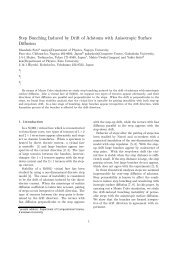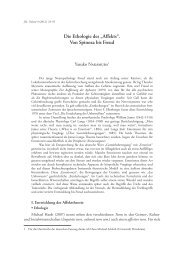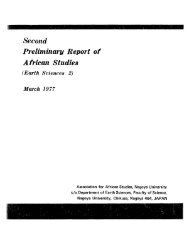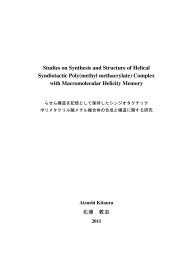k9254.pdf
k9254.pdf
k9254.pdf
You also want an ePaper? Increase the reach of your titles
YUMPU automatically turns print PDFs into web optimized ePapers that Google loves.
polymer-grafted surfaces can be prepared by ―grafting to‖ or ―grafting from‖ method. 8<br />
Comparing to the ―grafting to‖ method, high-density polymer grafted membrane, so-called<br />
―polymer brush‖, with well-controlled structure can be synthesized by the ―grafting from‖<br />
method. 9-12 In this work, we synthesized high-density polymer brushes of PNIPA on silicon<br />
surface by the ―grafting from‖ method using [11-(2-chloro)propionyloxy]undecyl-<br />
dimethylchlorosilane modified silicon and propargyl 2-chloropropionate/CuCl/Me6TREN (1:1:1)<br />
as the initiating system at 20°C and examined the kinetics of the ATRP system and the static<br />
structure of the resultant grafted membrane. Through variation of reaction time of<br />
polymerization, we showed that how the reaction time influenced the polymerization kinetics,<br />
evolution of number average molecular weight, Mn, molecular weight distribution, Mw/Mn, and<br />
the distinctive properties of the grafted membrane. Here we successfully showed that, ATRP of<br />
NIPA on silicon surface was precisely controlled to demonstrate a chain length of PNIPA as well<br />
as graft density. We also found a very interesting thermo-sensitivity of the PNIPA grafted<br />
membrane.<br />
2.2. EXPERIMENTAL SECTION.<br />
2.2.1. Self-Assembly of Initiator Monolayer on Silicon Wafers. 13<br />
The surface-attachable ATRP initiator ([11-(2-chloro)propionyloxy]undecyl-<br />
dimethylchlorosilane, CPU-dMCS), was synthesized by the hydrosilylation of 10-undecen-1-yl<br />
2-chloropropionate with chlorodimethylsilane in the presence of Karsted catalyst at room<br />
temperature for 6 hours (Figure2-1). 10-undecen-1-yl 2-chloropropionate was synthesized by a<br />
substitution chloride in the presence of triethylamine in dry-THF. 100 μl CPU-dMCS as a silane<br />
coupling solution was added into 100ml dry toluene in a glove box. Treated silicon wafers were<br />
then immersed into the silane coupling solution and were kept into a thermostat chamber at 60 o C<br />
for 84 hours to form a self-assembled initiator monolayer. The surface modified silicon wafers<br />
were then removed from solution and ultrasonically cleaned by dry toluene, rinsed sequentially<br />
with toluene and methanol, and then dried through an argon stream. The successful synthesizes<br />
of the ATRP initiator layer was verified by X-ray photoelectron spectroscopy (XPS).<br />
26









